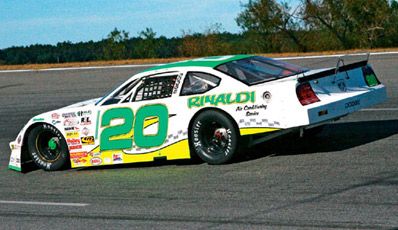
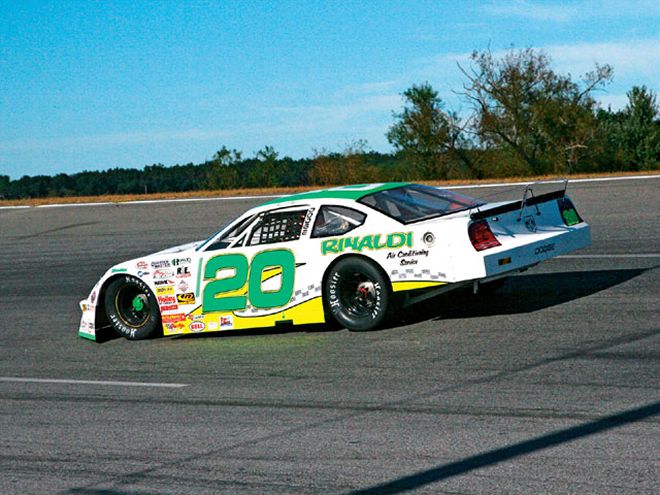 Shocks mostly determine the entry and exit characteristics of the racecar. To get the low and fl at attitude shown here, you need soft front springs, a stiff right rear spring and shocks that will hold the front end down for a period of time. But be careful what you ask for, the desired results can be elusive.
Shocks mostly determine the entry and exit characteristics of the racecar. To get the low and fl at attitude shown here, you need soft front springs, a stiff right rear spring and shocks that will hold the front end down for a period of time. But be careful what you ask for, the desired results can be elusive.
In the modern short track racing world of both dirt and asphalt competition, shocks have become one of the most important tuning tools we have. They compliment the current setups, especially the radical big bar and soft spring setups. And so, we complete our trilogy of shock technology articles with the final installment on how to tune the transitions.
This information is useful whether you are running more conventional setups or the more radical ones. Think along as we discuss how shocks affect the speed of movement and the load distribution at the four corners of the car as we transition from high speed to minimum and then to high speed again.
We have learned that shocks regulate the timing of movement of the four corners of our racecar. Matching the shocks to the springs on a conventional setup is fairly simple and can be done with off-the- shelf shocks. Matching the shocks to non-conventional setups can be a bit tricky. Let's take a look at how we can improve our overall setup package by helping our car negotiate the transitional phases of the racetrack.
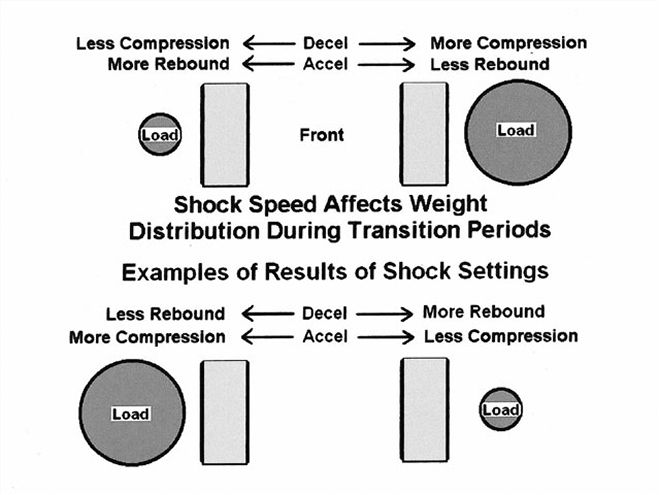 This sketch shows how increasing or decreasing the compression or rebound at each corner can tighten the car during transitions involving deceleration and acceleration. The changes shown will have the effect of making the car tighter by increasing the crossweight percent.
This sketch shows how increasing or decreasing the compression or rebound at each corner can tighten the car during transitions involving deceleration and acceleration. The changes shown will have the effect of making the car tighter by increasing the crossweight percent.
If we split the front shock compression rates with a LF 5/4 (5 rebound and 4 compression) and a RF 5/5, then, while the suspension is in motion due to weight being transferred on to it, then the RF suspension will move slower than the LF suspension. Additional weight will be transferred onto the RF and LR tires causing a momentary increase in the crossweight percent in the car. This obviously tightens the car.
It is important to note that contrary to some opinions, the load transfers almost immediately when a force is presented to enact that transfer. As we brake into the corner, the load transfer happens quickly. If on entry we transfer 300 pounds from the rear to the front, the 300 pounds goes to the front in an instant.
The distribution of that 300 pounds between the two front wheels, while the suspension is assuming a new attitude that will support the additional weight, will depend entirely on differences in stiffness of the suspension systems at all four corners. Stiffness is defined as the resistance to movement influenced by the shocks and springs.
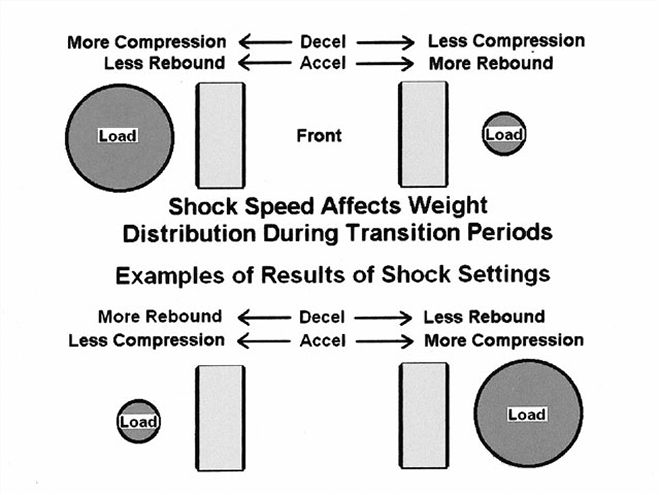 Here, we see how increasing or decreasing the compression or rebound at each corner can loosen the car during transitions involving deceleration and acceleration. The changes shown will have the effect of making the car looser by decreasing the crossweight percent.
Here, we see how increasing or decreasing the compression or rebound at each corner can loosen the car during transitions involving deceleration and acceleration. The changes shown will have the effect of making the car looser by decreasing the crossweight percent.
Reasoning out the effect of load transfer onto the front suspensions that are dissimilar in stiffness, the slower moving (or stiffer) corner will momentarily retain more of the transferred load while the suspension is moving to a new attitude to support the added weight. If the RF suspension is stiffer than the LF suspension, then both the RF and LR tires will support more of the total load.
Crossweight is defined in short track racing as the percent of the combined RF and LR weight vs. the total vehicle weight. If the crossweight percent increases, then the car will be tighter on entry and the car might be faster if that is the desired affect. This is exactly why it has been said that a stiffer RF shock will speed up weight transfer to that corner. In truth, some of the momentary load that has been transferred onto the RF due to that corner being stiffer than the LF corner may well return to the LF tire as the car reaches a steady state or a steady ride height at mid-turn.
If the car is already tight on entry, after having eliminated common causes of tight entry such as rear misalignment or brake bias issues, then an opposite effect can be utilized. If we increase the compression of the LF shock and/or increase the spring rate on that corner (which is usually a good idea for flat tracks), then we can effectively reduce the crossweight in the car on entry while the suspension is in transition by loading the opposite diagonal, the LF and RR. As one diagonal goes up in percentage of supported weight the other goes down.
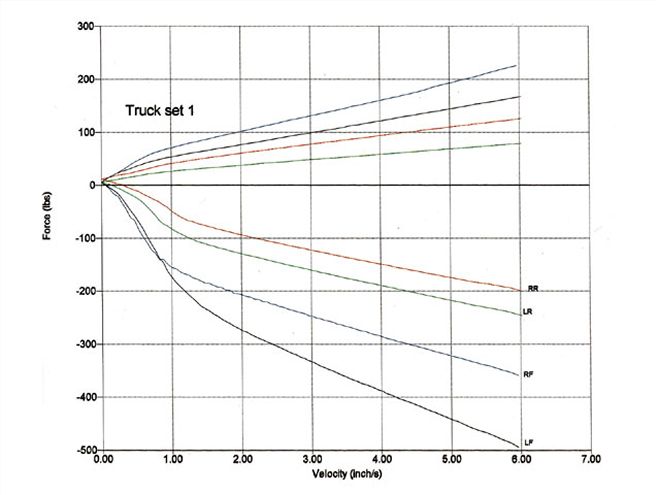 Adjustable shocks can be run on a dyno and graphed to show the rates at various settings. Here, we see a wide range of resistance for rebound and compression.This shock can be used for a wide variety of setups from fairly normal, conventional rates shown in red to the more current asphalt trend for high rebound and less compression shown in gray.
Adjustable shocks can be run on a dyno and graphed to show the rates at various settings. Here, we see a wide range of resistance for rebound and compression.This shock can be used for a wide variety of setups from fairly normal, conventional rates shown in red to the more current asphalt trend for high rebound and less compression shown in gray.
We can also work with the rear shock rebound rates to help effect changes in load distribution and corner entry characteristics. To neutralize a car that is tight on entry, a stiffer rebound setting in the LR shock and/or a softer rebound setting in the RR shock will cause more of the transferred load to be taken from the LR than the RR tire during the transitional period. This too causes a decrease in the RF and LR weight distribution percentage which loosens the handling momentarily while the suspensions are in motion.
Corner exit performance that utilizes the shocks is primarily tuned by splitting the compression settings in the rear shocks and/or the rebound settings in the front shocks. A stiffer compression setting in the LR shock will load the LR and RF corners as load is transferred to the rear while the rear suspension is in motion to tighten the car with more crossweight percent. A stiffer shock in rebound at the LF corner can help accomplish the same effect by causing a slower movement of that suspension and a more rapid transfer of load off of that corner which in turn increases the percentage of load supported by the RF and LR tires.
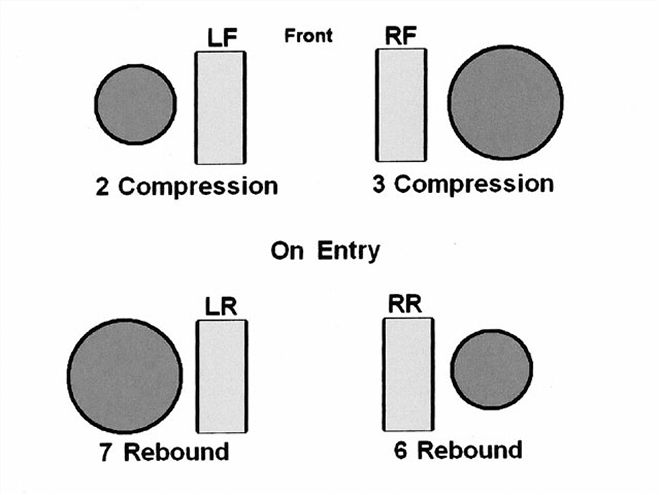 The trend in asphalt late-model racing is toward softer settings on compression and higher rebound rates. Here might be a typical layout using common numbers representing rates. For entry, this might create a slightly tight entry which is desirable for deeper entry and control.
The trend in asphalt late-model racing is toward softer settings on compression and higher rebound rates. Here might be a typical layout using common numbers representing rates. For entry, this might create a slightly tight entry which is desirable for deeper entry and control.
The term "tie down" is often used to refer to a shock that has a high resistance to rebound. If the rebound rates are higher for both left side shocks than those of the right side shocks, then as the car turns left (especially with quicker turning rates associated with smaller radius turns), the tendency for the left side suspensions to quickly rebound as load is transferred from the left side to the right side is reduced.
If we can stop the sudden motion, then we can keep the left side down on initial turn in and the chances are that the whole attitude of the car through the middle of the turns will be lower. A lower CG means less load transfer off the left side of the car and more retained left-side weight. For asphalt stock cars and dirt cars on higher banked tracks with grip, a higher left-side weight means more equally loaded tires, left to right, and more traction. The opposite is true of dirt cars on slick tracks.
The reverse term, or "easy up" shocks, are used to help raise the suspension quickly which does also raise the center of gravity of the sprung mass and a higher CG promotes more load transfer. Drag cars use this effect on the front of their cars to promote more load transfer to the rear tires for added traction. On dry slick dirt tracks, teams can utilize less rebound in the left side shocks and in the front shocks to promote load transfer to the right side for better side bite and to the rear for better traction off the corners.
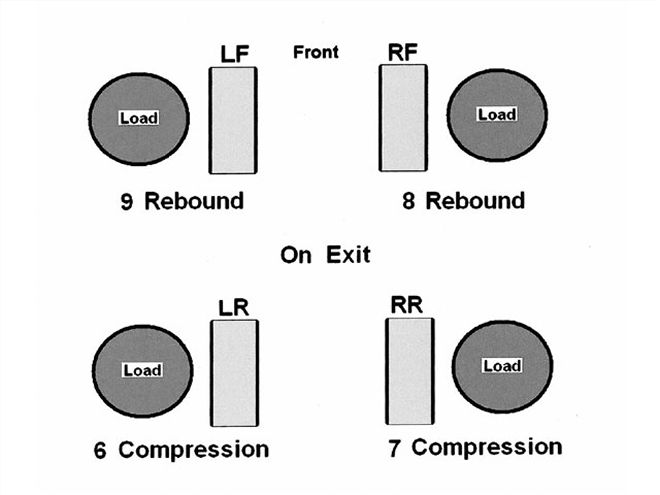 If the shock rates are arranged in a certain way, the load distribution will not be adversely affected with the high rebound rates at the front, countered by reverse emphasis at the rear. Note the higher rebound on the LF, countered by the higher compression at the RR and lower rebound at the RF, countered by the lower compression at the LR.
If the shock rates are arranged in a certain way, the load distribution will not be adversely affected with the high rebound rates at the front, countered by reverse emphasis at the rear. Note the higher rebound on the LF, countered by the higher compression at the RR and lower rebound at the RF, countered by the lower compression at the LR.
In order to utilize the configurations we have discussed here, we must be able to use a range of different rates of shocks in order to find the right combination for our car at a particular racetrack for a particular setup. For a team that races at only one track, the process is fairly simple. You would experiment to find the fastest set of shocks and ones that suit the driver's style and stick to those. For teams that travel to different tracks, some changes will be necessary if the setup needs to change and/or the track layout is different from track to track.
Most shock experts agree with certain basics, such as:
1. The shock package should be softer overall when racing on dirt and when the track is flatter when on asphalt for the conventional setups.
2. Get your basic setup close to being balanced before trying to tune with shocks. Shocks cannot solve basic handling balance problems.
3. Higher banked tracks require a higher overall rate of shock as opposed to flat tracks. This is because of the higher speeds and the extreme amount of downforce.
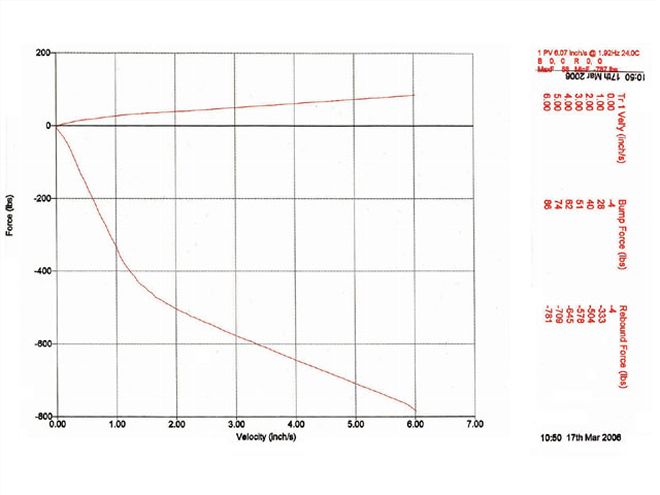 For extreme tie down, we see where there is very little in the way of compression resistance and a lot of rebound resistance. This direction is what teams usually experience in the quest to go fast, but usually back off from when the handling balance becomes unpredictable.
For extreme tie down, we see where there is very little in the way of compression resistance and a lot of rebound resistance. This direction is what teams usually experience in the quest to go fast, but usually back off from when the handling balance becomes unpredictable.
4. Shocks that are mounted farther from the ball joint should be stiffer than if they were mounted close to the ball joint. That is because with each inch of travel of the wheel, the shock mounted farther away will move at a lesser speed which means less resistance to both rebound and compression.
5. Tune entry performance first. If there are no entry problems, make small changes if you want to experiment to see if entry can be improved. Entry problems include a tight car or a loose car. By far the worst problem would be the loose-in condition. Nine times out of ten this is an alignment problem and not shock related.
6. Tune exit performance last. If there are no exit problems, don't make any significant changes. Exit problems can include a car that pushes under acceleration or one that goes loose under power. Be sure that you do not have a tight/loose condition where the car is basically tight in the middle and goes loose just past mid-turn.
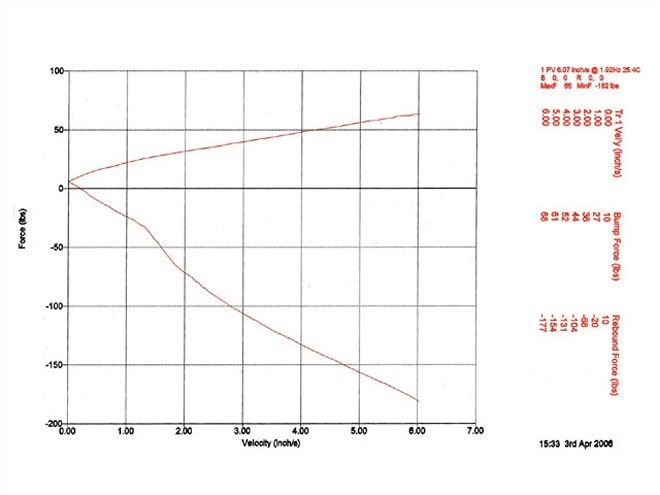 A more moderate setting for tie down is shown here where we see reduced rebound rates for the slower speeds up to two inches per second, then increasing as the speeds increase. This is probably do-able for the LF on a BBSS setup.
A more moderate setting for tie down is shown here where we see reduced rebound rates for the slower speeds up to two inches per second, then increasing as the speeds increase. This is probably do-able for the LF on a BBSS setup.
7. On dirt racetracks, reduce rebound settings on the left side and decrease the compression rates on the right side for dry slick surfaces to promote more chassis movement. This helps to maintain grip as the car goes through the transitional phases of entry and exit.
8. On asphalt tracks, once the car has been tuned with shocks for optimum entry and exit performance, increase the overall rebound rates a small step at a time, especially on the left side, to possibly increase overall performance. This is especially good for low to medium banked racetracks. For highly banked tracks, the added rebound is not necessary or advisable.
The suggestions provided here are representative of trends that can enhance your handling package. Before any of this can work, the setup must be balanced, the steering characteristics must be ideal and the car must be aligned properly. If not, you will probably chase the setup and experience a lot of frustration and expense. Shock tuning is the last thing to experiment with in order to try to increase your racecar's performance, but it is nonetheless a necessary step in finding the ideal total handling package.